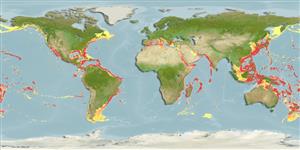Common names from other countries
Classification / Names / Names
Common names | Synonyms | Catalog of Fishes (gen., sp.) | ITIS | CoL | WoRMS
Environment: milieu / climate zone / depth range / distribution range
Ecology
Pelagic; depth range 0 - 1234 m (Ref. 83435). Tropical
Indo-Pacific, Western Atlantic and the Mediterranean Sea. Tropical and subtropical.
Length at first maturity / Size / Weight / Age
Maturity: Lm ? range ? - ? cm Max length : 3.3 cm DL male/unsexed; (Ref. 83435)
Filter feeder that strains microscopic organisms such as diatoms from the water (Ref. 866). Suspension feeder (Ref. 109264). Most abundant in the upper 100 m of the open ocean, but also common to the inner neritic zone (Ref. 83534). Dead shells washed up on the beaches (Ref. 88739).
Life cycle and mating behavior
Maturity | Reproduction | Spawning | Eggs | Fecundity | Larvae
Members of the order Thecosomata are mostly simultaneous hermaphrodites.
Templado, J. and R. Villanueva. 2010. (Ref. 85339)
IUCN Red List Status (Ref. 130435)
CITES status (Ref. 108899)
Not Evaluated
Not Evaluated
Human uses
| FishSource |
Tools
More information
Age/Size
Growth
Length-weight
Length-length
Morphology
Larvae
Abundance
Internet sources
Estimates based on models
Preferred temperature
(Ref.
115969): 2.1 - 18.7, mean 10 (based on 1601 cells).
Price category
Unknown.
